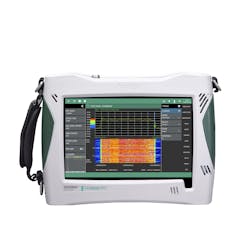Real-time spectrum analyzers offer high-tech way to hunt down interference and adversaries
MORGAN HILL, Calif., - While traditional spectrum analyzers will continue to be a "workhorse" technology for radio frequency (RF) engineers, real-time spectrum analyzers (RTSA) offer myriad benefits for industries and agencies looking to glean additional insights into signals across the spectrum.
Spectrum analyzers allow for the measurement of power inside a given bandwidth at a specific frequency and display those measurements across a frequency span.
With real-time analysis, experts can conduct continuous, gapless capture and analysis of elusive and transient signals which is not something conventional spectrum analyzers and vector signal analyzers can do. This allows for signal-in-signal monitoring for traffic that should not be there or may be causing interference.
In addition, a RTSA can alert people to fast-changing signals, or if a piece of RF equipment, such as a radar installation, is broadcasting when it should not be, which can impact mission success. RTSA can also help recognize threats hiding in broadcasts by utilizing the same spectrum.
Military & Aerospace Electronics reached out to experts at the U.S. Test and Measurement division of the Anritsu Corporation, located in Morgan Hill, Calif., to learn more about how companies and agencies could benefit by utilizing RTSAs. Kirby Hong, product manager, and Angus Robinson, marketing manager for handheld products, noted that RTSAs give a much broader view compared to traditional technology of what’s going on in the spectrum compared to traditional technology.
“The regular spectrum analyzer that we've known and loved for 30 years or more is not going to go away and still very much has a place in the spectrum analysis market,” says Robinson. “But what a real-time spectrum analyzer gives us is new insights that were very difficult to capture with a regular spectrum analyzer.”
Robinson noted that with older technology, companies would have to spend “hundreds of thousands of dollars on some sort of very sophisticated signal processing” to achieve what is possible now with a hand-held unit.
With traditional analyzers, Robinson says, “You're only looking at one part of the spectrum, but with a real-time spectrum analyzer you're seeing all of this - all of the spectrum up to a given span continuously…so transient signals are not missed and fast-moving signals within that bandwidth can be tracked.”
Picking up transient signals can help show security vulnerabilities in equipment or expose malicious actors.
“It would be used for spectrum clearing to check to see in a base environment if there's any unknown or unwanted transmitters that could affect the security of these operations,” says Anritsu’s Hong. “The second [use] could be general maintenance [of equipment]. Is it performing correctly? Are they meeting their specifications? When the radar is turned off, does it unintentionally emit spurious signals? It could be a security problem. Look for illegal listening devices, especially those that have a very transient nature that isn't broadcasting all the time. [If] there's a bug recording conversations, and periodically it transmits to a receiver station somewhere, that could be missed by a traditional spectrum analyzer.”
In addition to ferreting out potential security vulnerabilities, RTSAs can help recognize signals interfering within mobile communications systems. In a use study published by Anritsu, the company described an instance where a public safety agency in Nevada was experiencing intermittent receive interference alarms on its 800 MHz P25 communications system. After employing a traditional swept-tuned spectrum analyzer to locate the interfering signals and having no success, it was decided that the cause of the issue was likely to be an interfering signal with short duration or even a hopping signal, and a RTSA would be needed.
Anritsu’s Field Master Pro MS2090A solution with real-time spectrum analyzer option was selected to locate the interfering signal. According to the manufacturer, in the optional real-time mode, the MS2090A can accurately measure the amplitude of a single spectrum event as short as 2 µs and detect a single event as short as 5 ns. The MS2090A is a ruggedized, size, weight, and power (SWaP) optimized, field-deployable handheld spectrum analyzer that has a 110 MHz analysis bandwidth and an measurement range from DANL to +30 dBm.
Using the MS2090A RTSA, experts were able to find the cause of the interference alarms at the public safety agency: high wind caused a cable to bang up against the tower, causing passive intermodulation.
The MS2090A can be utilized for interference hunting, spectrum clearing, broadcast transmitter analysis, monitoring microwave radio links, satellite system monitoring, pulse radar measurements, 5GNR base station measurement, and 5G coverage mapping.
Hong and Robinson noted that due to SWaP optimization, the battery-powered Field Master Pro MS2090A can be mounted into aircraft, vehicles, and deployed nondescriptly in cases to keep an inconspicuous eye on signals across the spectrum in real time.
“One of the government agencies we've been talking to is currently mounting into airframes, inside military aircraft, very large lab type instruments for exactly this application,” says Robinson. “And so, you can imagine anything that you're putting up in an airframe in terms of weight and size is a big issue. They’re very excited about the small form factor and the ability to get that same functionality in a in a much smaller form factor. There's also a group of people who want to leave these units in, say, unsuspicious looking Pelican cases…It's got a big battery in the case as well, and they leave it gathering data somewhere for a day or what have you and then come back home and pick it up.”
“On top of that, it also has IQ capture and IQ streaming capabilities,” noted Hong. That would come into play when aerospace or mil users want to analyze the signal further.”
To learn more about Anritsu’s Field Master Pro MS2090A, please visit https://www.anritsu.com/en-us/test-measurement/products/ms2090a. To learn more about Anritsu’s test and measurement offerings, please visit https://www.anritsu.com/en-US/test-measurement.
